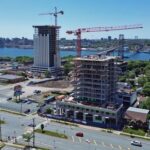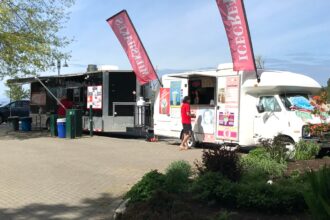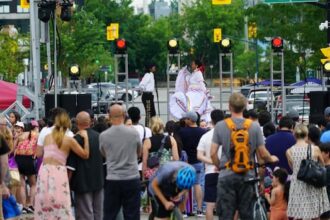The heart of downtown London, Ontario transformed into a colorful celebration of Colombian heritage this past weekend as the annual Colombian Culture Festival took over Victoria Park. Under perfectly blue summer skies, thousands of attendees experienced the rich tapestry of Colombian traditions through food, music, dance, and art.
From the moment I arrived, the festival atmosphere was intoxicating. The scent of sizzling arepas and empanadas filled the air, mixing with the rhythmic beats of cumbia and vallenato music that seemed to pulse through the entire park. Children with faces painted in the yellow, blue, and red of the Colombian flag darted between vendor stalls while their parents sampled authentic Colombian coffee.
“This is our fourth year organizing the festival, and it grows more popular every year,” explained Maria Gonzalez, president of the Colombian-Canadian Association of London. “We started with just a few hundred attendees in 2020, and now we’re seeing thousands of people—both from the Colombian community and Londoners curious about our culture.”
What struck me most was how the festival served as both a homecoming for London’s Colombian community and a vibrant introduction to Colombian culture for others. Intergenerational families moved through the crowd, grandparents pointing out traditional crafts to their Canadian-born grandchildren, creating bridges between their heritage and their present lives in Canada.
The festival featured over 30 food vendors offering regional specialties from across Colombia. Attendees lined up for bandeja paisa (a hearty platter featuring beans, rice, plantains, and various meats), ajiaco (a potato and corn soup), and buñuelos (cheese fritters). The culinary diversity on display reflected Colombia’s varied geography, from coastal regions to Andean highlands.
“Food is how we stay connected to home,” shared Jorge Ramirez, owner of El Costeño, one of the most popular food stalls at the event. “When Canadians taste our dishes, they’re experiencing centuries of our history and culture. That’s powerful.”
Beyond the food, the festival showcased traditional folk dances performed by the Raices Colombianas dance troupe. Their cumbia performance, with women in flowing white dresses and men in white attire with red scarves, captivated the audience. The dance’s origins—a courtship ritual blending indigenous, African, and Spanish influences—mirrors Colombia’s rich cultural fusion.
The festival wasn’t merely celebratory; it also served as an educational platform. A special exhibition area displayed information about Colombia’s diverse regions, indigenous populations, and historical developments. For many visitors, this was their first deep dive into Colombian history beyond coffee and the stereotypes perpetuated in popular media.
This cultural exchange represents something larger happening across Canada. As our CO24 Culture section has documented, cultural festivals have become increasingly important spaces for diaspora communities to maintain connections to their heritage while introducing their traditions to the broader Canadian society.
The economic impact shouldn’t be overlooked either. According to the Downtown London Business Association, cultural festivals like this one bring significant foot traffic and revenue to local businesses. “We’ve seen a 30% increase in sales during festival weekends,” noted Emma Thompson, manager at a café adjacent to Victoria Park. “These events are vital to our downtown’s vitality.”
What makes the Colombian Culture Festival particularly successful is its accessibility. Unlike some cultural events that can feel exclusive or intimidating to outsiders, this festival was designed to welcome everyone. Volunteers stationed throughout the park eagerly explained traditions, helped translate food menus, and encouraged participation in dances and activities.
Recent CO24 Trends research indicates that immersive cultural experiences are becoming increasingly sought after by Canadians looking to expand their worldviews without international travel. The popularity of the Colombian festival speaks to this growing desire for authentic cultural engagement.
As the evening settled in, the festival shifted from family-friendly daytime activities to a more vibrant nighttime celebration. Professional musicians took to the main stage, performing contemporary Colombian music that blends traditional sounds with modern influences. The crowd, now a mix of Colombian-Canadians and cultural enthusiasts from across the city, danced together as the park lit up with colorful lights.
In an era where our differences are often politicized, events like the Colombian Culture Festival remind us of the enriching potential of cultural exchange. As I watched a group of seniors teaching young Canadians the basic steps of cumbia, I was reminded that the best cultural education happens not through textbooks but through shared experiences, laughter, and, of course, food.
The Colombian Culture Festival returns to London next summer, but its impact resonates far beyond a single weekend. In a thoughtful CO24 Opinions piece last month, we explored how cultural festivals contribute to the evolving Canadian identity—one that increasingly recognizes the value of preserving distinct cultural traditions within our multicultural mosaic.
As I left Victoria Park that evening, the sounds of celebration still echoing behind me, I wondered: In a world that sometimes seems determined to build walls between cultures, could these festivals be one of our most effective forms of bridge-building?























